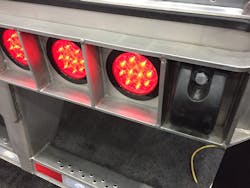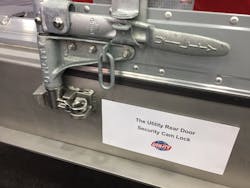Utility: Demand is putting pressure on trailer production
A now long-running boom in orders that began last year is starting to put pressure on trailer production levels as manufacturers scramble to maintain supplies of key components such as tires, landing gear, and suspensions.
“The market is very strong and it’s becoming a monumental challenge to keep up with demand, especially in terms of material supply,” Craig Bennett, senior vice president of sales and marketing for Utility Trailer Manufacturing Co., explained to Fleet Owner during the recent Mid America Trucking Show.
“We’re struggling, as are all the [trailer] OEMs, with the supply of ‘basic stuff’ like tires and suspensions – it’s sometimes hand-to-mouth,” he said. “That is a major issue because we don’t want to go to a second or third tier component just to meet demand.”
According to ACT Research, “historically strong” net trailer order volumes in the final two months of 2017 were followed by more of the same in the first two months of 2018, with February’s net orders the “strongest February net order volume in industry history” and also 14th highest on the all-time list for monthly orders.
“Dry vans and reefers [refrigerated] trailers were off sequentially [while] flatbeds had the best monthly gain,” noted Frank Maly, ACT’s director–CV transportation analysis and research, in a separate statement. “On a year-over-year basis, eight of the 10 trailer categories were up, with liquid tank orders more than double last year. Total industry net volume was up 27% year-over-year.”
As every trailer category posted both sequential gains and year-over-year improvement of backlogs in February, that continues to indicate “widespread fleet investment,” he explained. “Production is beginning to increase [and] the increase in build rates offset the gains in backlog, resulting in the backlog/build rate ratio ending February at seven months. That commits the industry, on average, through September, with both dry van and reefer [demand] stretched into the fourth quarter.”
Bennett said the most “traffic” Utility is experiencing in orders right now is for dry van trailers. “For the most part, [motor] carriers have freight and if they have the drivers to haul it, they want new equipment,” he said. “They are replacing their old units right now for the most part but there is some expansion going on. We’re also beginning to see more drop-and-hook plus hub-and-spoke style operations so they can get drivers home more often.”
That “operational shift” – which is also leading to reduced lengths of haul – is also increasing the “duty-cycle pressures” on trailers, Bennett point out, especially on dry van and reefer models. “What wears a trailer out is bumping docks and forklift loading and unloading activity,” he explained. “It’s not going up and down the road that wears a trailer out.”
As a result, Utility is seeing an uptick in demand for more “durable” specs, such as its 24,000-lb. load-rated floor options for its reefer trailers. “We’re seeing fleets pull the trigger more on specs like that,” Bennett said. “The problem is the people buying the trailers don’t see the extra stress they are being put under today. They don’t think about trailers the way they do tractors. They think it will last 10 or 12 years even if you increase the amount of wear-and-tear it takes due to more frequent dock visits and carrying heavier [freight] pallets. That is the message we need to get out there.”Getting trailers to last longer in heavier-use patterns in part involves making small design changes, Bennett added. For example, in an impromptu tour of a Utility 3000R reefer trailer at his company’s Mid America booth, Bennett noted that the OEM now uses rounded rear bumper nodes versus previously square designs. “That rounded shape doesn’t suffer dock cuts the way the square-shaped bumpers did,” he said.
A second cargo securement locking system is now built within the trailer’s rear bumper plate, instead of outside it, again to minimize the potential for damage when backing up to freight docks. And Bennett noted that the red stripe that used to be painted along the top of the interior walls of its 3000R trailer – a visual “loading line” cue to allow for cold air circulation within the unit – is now working into the wall material itself so it will not fade or be scrubbed off.
“These things are small items but they make a lot of sense when you’re trying to maintain a 10-year or more life cycle on a trailer that is seeing more use,” he said.
Utility brought its newest flatbed model, the 4000AE drop deck trailer, to the show; a “combo flatbed” that uses both steel and aluminum in its construction to provide nearly the same weight savings and longevity of an all-aluminum trailer but at a much lower price.
Designed to haul heavy or awkward loads, the 4000AE features a combination of 3-in. and 4-in. aluminum crossmembers and comes standard with a 39,000-lb. coil haul package with a 5-ft. span of 4-in. tapered to 3-in. aluminum crossmembers on 8-in. centerlines. The 4000AE also features the ConMet aluminum hub system and delivers an additional 541 lbs. of weight savings compared to the previous design, the OEM noted.
“What we’ve tried to do is blend the weight savings of aluminum with the strength of steel,” Bennett said. “The steel beams and crossmembers on this trailer have less flexibility so the load won’t ‘bounce’ on the trailer, which can force a driver to re-secure the load. The design makes a lot of sense from a cost and longevity perspective.”
About the Author
Sean Kilcarr
Editor in Chief
Sean Kilcarr is a former longtime FleetOwner senior editor who wrote for the publication from 2000 to 2018. He served as editor-in-chief from 2017 to 2018.


